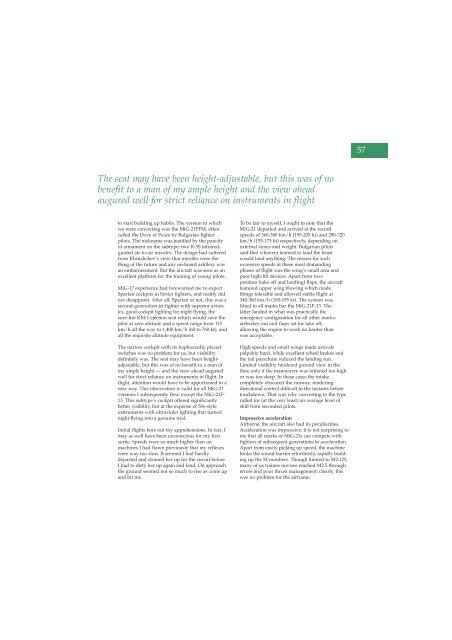Volume 6 No 4 - Royal Air Force Centre for Air Power Studies
Volume 6 No 4 - Royal Air Force Centre for Air Power Studies
Volume 6 No 4 - Royal Air Force Centre for Air Power Studies
Create successful ePaper yourself
Turn your PDF publications into a flip-book with our unique Google optimized e-Paper software.
57<br />
The seat may have been height-adjustable, but this was of no<br />
benefit to a man of my ample height and the view ahead<br />
augured well <strong>for</strong> strict reliance on instruments in flight<br />
to start building up habits. The version to which<br />
we were converting was the MiG-21PFM, often<br />
called the Dove of Peace by Bulgarian fighter<br />
pilots. The nickname was justified by the paucity<br />
of armament on the subtype: two R-3S infraredguided<br />
air-to-air missiles. The design had suffered<br />
from Khrushchev’s view that missiles were the<br />
thing of the future and any on-board artillery was<br />
an embarrassment. But the aircraft was seen as an<br />
excellent plat<strong>for</strong>m <strong>for</strong> the training of young pilots.<br />
MiG-17 experience had <strong>for</strong>ewarned me to expect<br />
Spartan cockpits in Soviet fighters, and reality did<br />
not disappoint. After all, Spartan or not, this was a<br />
second-generation jet fighter with superior avionics,<br />
good cockpit lighting <strong>for</strong> night flying, the<br />
sure-fire KM-1 ejection seat which would save the<br />
pilot at zero altitude and a speed range from 115<br />
km/h all the way to 1,400 km/h (60 to 760 kt), and<br />
all the requisite altitude equipment.<br />
The narrow cockpit with its haphazardly placed<br />
switches was no problem <strong>for</strong> us, but visibility<br />
definitely was. The seat may have been heightadjustable,<br />
but this was of no benefit to a man of<br />
my ample height — and the view ahead augured<br />
well <strong>for</strong> strict reliance on instruments in flight. In<br />
flight, attention would have to be apportioned in a<br />
new way. This observation is valid <strong>for</strong> all MiG-21<br />
versions I subsequently flew, except the MiG-21F-<br />
13. This subtype’s cockpit offered significantly<br />
better visibility, but at the expense of 50s-style<br />
instruments with ultraviolet lighting that turned<br />
night flying into a genuine trial.<br />
Initial flights bore out my apprehensions. In fact, I<br />
may as well have been unconscious <strong>for</strong> my first<br />
sortie. Speeds were so much higher than on<br />
machines I had flown previously that my reflexes<br />
were way too slow. It seemed I had hardly<br />
departed and cleaned her up <strong>for</strong> the circuit be<strong>for</strong>e<br />
I had to dirty her up again and land. On approach<br />
the ground seemed not so much to rise as come up<br />
and hit me.<br />
To be fair to myself, I ought to note that the<br />
MiG-21 departed and arrived at the record<br />
speeds of 360-380 km/h (195-205 kt) and 290-320<br />
km/h (155-175 kt) respectively, depending on<br />
external stores and weight. Bulgarian pilots<br />
said that whoever learned to land the beast<br />
would land anything. The reason <strong>for</strong> such<br />
excessive speeds at these most demanding<br />
phases of flight was the wing’s small area and<br />
poor high-lift devices. Apart from twoposition<br />
(take off and landing) flaps, the aircraft<br />
featured upper wing blowing which made<br />
things tolerable and allowed stable flight at<br />
340-360 km/h (185-195 kt). The system was<br />
fitted to all marks bar the MiG-21F-13. The<br />
latter landed in what was practically the<br />
emergency configuration <strong>for</strong> all other marks:<br />
airbrakes out and flaps set <strong>for</strong> take off,<br />
allowing the engine to work no harder than<br />
was acceptable.<br />
High speeds and small wings made arrivals<br />
palpably hard, while excellent wheel brakes and<br />
the tail parachute reduced the landing run.<br />
Limited visibility hindered ground view in the<br />
flare only if the manoeuvre was initiated too high<br />
or was too steep. In these cases the intake<br />
completely obscured the runway, rendering<br />
directional control difficult in the instants be<strong>for</strong>e<br />
touchdown. That was why converting to the type<br />
called <strong>for</strong> (at the very least) an average level of<br />
skill from seconded pilots.<br />
Impressive acceleration<br />
<strong>Air</strong>borne, the aircraft also had its peculiarities.<br />
Acceleration was impressive: it is not surprising to<br />
me that all marks of MiG-21s can compete with<br />
fighters of subsequent generations in acceleration.<br />
Apart from easily picking up speed, the machine<br />
broke the sound barrier ef<strong>for</strong>tlessly, rapidly building<br />
up the M numbers. Though limited to M2.125,<br />
many of us trainee novices reached M2.5 through<br />
errors and poor thrust management: clearly, this<br />
was no problem <strong>for</strong> the airframe.
















